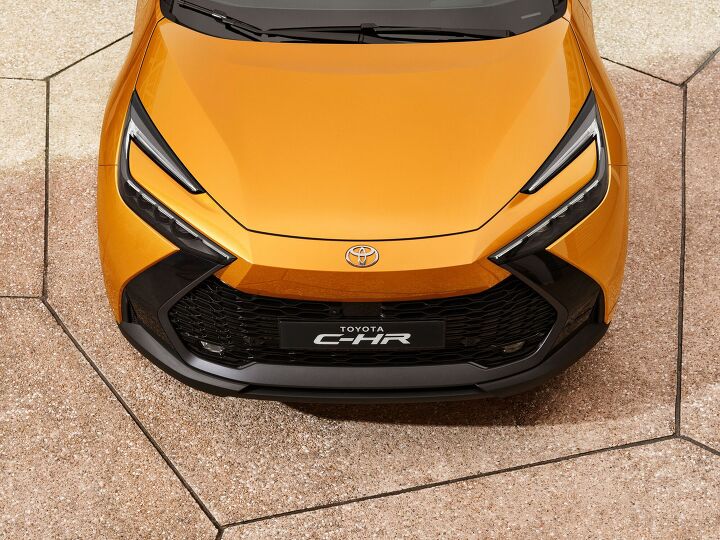
Toyota has released the second generation of the C-HR subcompact crossover and looks to have made numerous improvements to the vehicle. But it doesn’t sound like we’ll be seeing it on our market after the original model failed to resonate with North American consumers.
We also have the Toyota Corolla Cross available for purchase, resulting in some troublesome overlap. While still extremely slow in its base configuration, the Cross ended up being significantly quicker than the C-HR and offered improved utility for a little less money. However, with the new generation having addressed some of the discontinued model’s shortcomings, one wonders if the new C-HR would have a better chance were it to be shipped stateside.

The original’s 2.0-liter engine offered 144 horsepower and 139 lb-ft of torque. But the combination failed to see the crossover reach 60 mph in under 11 seconds. That’s really slow for a modern automobile and was made worse by the vehicle’s extremely bland driving dynamics. Though that’s been an issue for crossovers in general since they came into existence.
Still, none of the above ended up being a trade-off for improved utility or sublime fuel economy. The rear seats on the C-HR were exceptionally tight and there was not a lot of room for storage behind them. Meanwhile, customers were getting the kind of fuel economy one would expect from a modern performance sedan. Hell, even the Honda Civic Type R is supposed to yield 36 mpg on the highway when the C-HR was only able to manage 31 mpg.

While arguably less interesting to look at, the Corolla Cross managed to address every one of those issues and opened up the door for customers who might want to option all-wheel drive and a hybrid powertrain. Granted, the Mazda CX-30 is light years better to drive and there’s a slew of excellent Hyundai and Kia-branded crossovers that you should probably cross-shop. But the Corolla Cross basically guaranteed there would be no room for the C-HR at American Toyota dealerships.
Would that remain true if we had held out for the second generation?

The new model is clearly designed by the same team that worked up the all-new Toyota Prius. While the C-HR is noticeably shorter in overall length, the manufacturer probably could have branded it as the Prius Sport Cross. Now hybrid only, with customers having the ability to choose between the base 1.8-liter hybrid or larger 2.0-liter hybrid that can be paired with optional all-wheel drive. The larger powertrain is even available as a plug-in version that makes 223 horsepower and supposedly offers 41 miles of all-electric range. Though we imagine that figure would come down a bit if certified by the EPA.
Models equipped with the base 1.8-liter are supposed to be 100 kilometers per hour (62 mph) in 9.9 seconds. While that’s not fast, it’s over a second quicker than the previous generation. Front-drive versions of the 2.0-liter are said to take 8.1 seconds to reach 62 mph, while the all-wheel drive alternative is supposed to take 7.9 seconds. The PHEV is a little faster at 7.4 seconds. But they all tap out at 112 mph, while the 1.8-liter isn’t supposed to do more than 106 mph.

A decidedly more modern interior has been fitted to the second-gen C-HR, offering a 12.3-inch digital instrument panel and identically sized central touch screen. But Toyota has wisely decided to retain physical buttons for the features you’re likely to interface with on a daily basis. European regulations guarantee a slew of electronic nannies bundled under the banner of “advanced driving aids.” This includes a feature on the PHEV that automatically switches the car to EV operation when it enters a government-identified low emission zone (LEZ).
Slicker versions of the model are available with a head-up display, panoramic roof, upgraded JLB audio systems, and endlessly customizable ambient lighting. The latter option even has the ability to be tweaked to change as the day progresses, giving you hourly color changes or specific themes for the kind of driving you’re doing. Interior lighting can even change to alert drivers to hazards, lighting the cabin up in red to indicate the car is worried about the possibility of a collision.

The Smart Connect multimedia package will be available, offering a voice assistant, wireless smartphone connection via Apple CarPlay or Android Auto, and loads of ways to control the vehicle via your smartphone. Automatic parking (even without the owner being in the vehicle) will be an option, as will a digital key system, where the user only has to have their phone on their person to access and start the car.
Toyota said sustainability and customization were key components of the new C-HR and the car comes with the ability to save three driver presets that are accessible via the steering wheel. There is also a slew of flashy paint options, including some two-tone selections.

Upholstery is said to be made from recycled materials and will be offered in some unique configurations. The GR Sport Premiere Edition comes with an even flashier interior with exterior paint options to match. Though nobody should expect a bump in performance just because it’s wearing the GR badge.
The segment is over-saturated and we already have the Corolla Cross, so it’s not like we needed the 2024 Toyota C-HR. But something tells me that the manufacturer would have had better luck with the original if it had more in common with the updated model. Sound off if you’d like to have the chance to test drive one or are just glad it’s gone.

[Images: Toyota]
Become a TTAC insider. Get the latest news, features, TTAC takes, and everything else that gets to the truth about cars first by subscribing to our newsletter.
from TheTruthAboutCars https://www.thetruthaboutcars.com/cars/news-blog/2024-toyota-c-hr-debuts-elsewhere-does-our-market-care-44501590?utm_medium=auto&utm_source=rss&utm_campaign=all_full
No comments:
Post a Comment